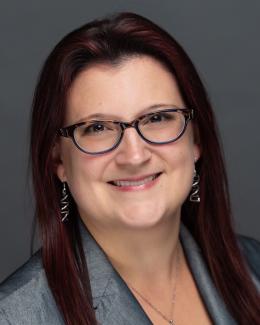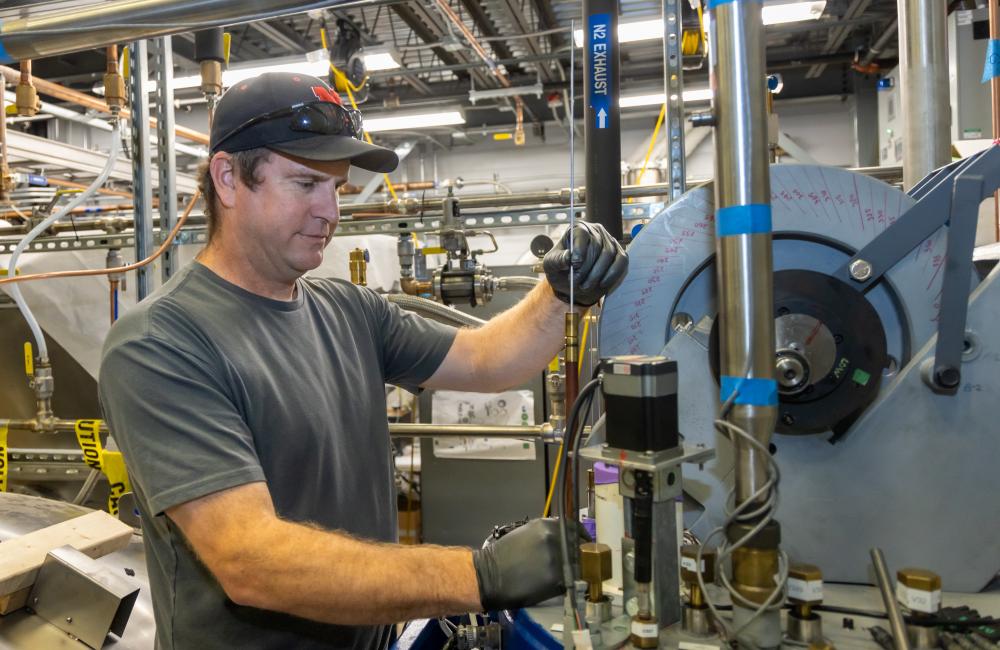Sean Hollander beams when he describes his work on the beamline at the Department of Energy’s Oak Ridge National Laboratory.
Hollander, an associate technician in the Neutron Symmetries group who has been at ORNL only since December 2022, is enthusiastic about maintaining and servicing the beamline assemblies and associated hardware at one of the world’s most powerful research facilities.
The beam is the Fundamental Neutron Physics Beamline, which is operated by the Physics Division at the Spallation Neutron Source, a DOE Office of Science user facility at ORNL where scientists use neutrons to study all manner of matter. SNS uses a beam of protons accelerated to almost the speed of light to generate a pulse that strikes a liquid mercury target, producing beams of neutrons. Scientists use the neutrons to probe inside materials. In this case, physicists study the neutrons themselves for clues to the origins of the universe and all that is in it.
But the beam doesn’t maintain itself. It takes a team, and although Hollander is the only technician in his group, many others lend a hand in operating and maintaining the helium liquefier, cryogenics and vacuum system that are required for the instrument and for scientists to accomplish their research.
“There are lots of things to do around beam line assemblies,” Hollander said. “We often have to disassemble and assemble as part of the maintenance.”
The people are the reason he is so effusive, he said. “I really do like it here. The people are really easy to work with and easy to get along with. And it’s something different every day, and that’s what I like.”
Among the team members he works with are Weijun Yao, cryophysicist; Alexander Saunders, group leader; John Ramsey, chief engineer; Leah Broussard, research scientist; Vince Cianciolo, research staff; Seppo Penttila, guest scientist; Brad Filippone, professor at the California Institute of Technology; and Jason Newby and Chang-Hong Yu, senior researchers in the Neutrino Research group.
Before coming to ORNL last year, Hollander worked seven years at Los Alamos National Laboratory, New Mexico, following somewhat in the footsteps of J. Robert Oppenheimer, the Manhattan Project physicist who started the lab at Los Alamos and also spent time at Oak Ridge, where plutonium was being produced.
At Los Alamos, Hollander ran liquefiers, “and that’s probably what got me the job here,” he said. Much of his time now is spent preparing for an experiment, the Neutron Electric Dipole Moment at the SNS, or nEDM@SNS, which uses the beam of neutrons to precisely measure the neutron’s electric dipole moment. That information could reveal secrets of the universe, and when that happens, Hollander will have had a critical hand in helping physicists understand the nature of matter and how it came into existence.
He is also integral to the neutron “a” and “b”, or Nab, experiment, where he helps with assemblies and whatever else the scientists need. “It’s taking things apart and putting them back together. Then you test them, and then you put the next assembly together,” Hollander said.
Once a week he works with the Neutrino Research group helping build a vacuum chamber to test outgassing of 3D printed material as part of the Large Enriched Germanium Experiment for Neutrinoless Decay, or LEGEND project. LEGEND is a collaboration of more than 250 scientists around the world proposing to deploy germanium detectors deep underground in a research lab with the goal of understanding the nature of matter. Again, Hollander’s technical expertise comes to bear on discoveries about the universe.
Hollander recently was recognized for his work, receiving the Best New Technician award from ORNL’s Physical Sciences Directorate “for excellent cryogenic and vacuum work on nEDM and Nab experiments at the SNS,” according to the citation.
Cryogenics and vacuum systems were not always his passion. Before his work at Los Alamos, Hollander, a native New Mexican, was a teacher for 23 years, instructing preschool and elementary Montessori school students in science, social studies and physical education. He received an associate degree from the University of New Mexico, and finally left teaching for good to work at the local national laboratory in 2017. Teaching, he said, had become increasingly a challenge.
But national labs were in his blood: His father was an engineer at Los Alamos, and he grew up around a research enterprise. He developed, with his father mentoring, “a really good mechanical background.” He rebuilt cars, raced dragsters that he worked on, and did many hands-on projects as well as home renovations. Currently, he is working with another kind of beam, renovating his home in Oak Ridge, Tennessee, in his spare time.
Not that there is a lot of that. Hollander and his wife, Tia, a biologist at ORNL, have three active daughters. The family is enjoying their new environment, which has water, flora and fauna that they did not have in New Mexico.
“It’s quite the change, and there are more things to do here,” he said. A golfer and sports fan, he likes to camp with the family, but spends most of his time “trying to keep up with the kids and their sports,” he added. Another thing, it turns out, that keeps him beaming.
UT-Battelle manages ORNL for DOE’s Office of Science, the single largest supporter of basic research in the physical sciences in the United States. DOE’s Office of Science is working to address some of the most pressing challenges of our time. For more information, visit https://energy.gov/science. —Lawrence Bernard



